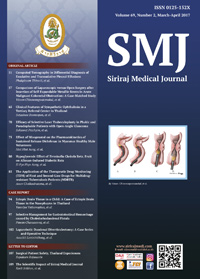Selective Management for Gastrointestinal Hemorrhage caused by Choledochoduodenal Fistula
Keywords:
Choledochoduodenal fistula, choledochoenteric fistula, gastrointestinal hemorrhageAbstract
Background: To report a patient of choledochoduodenal fistulae (CDF) who presented with melena and review a specific treatment for CDF.
Methods: This study was designed as a retrospective chart review using patient’s clinical data, imaging, endoscopic report, treatment review, and literature review for treatment options.
Results: A 74-year-old female presented with diffuse, non-tender abdominal pain and associated melena for one week. Physical examination showed mildly icteric sclera and mild epigastric tenderness on deep palpation. Initial diagnoses included cholangitis with anemia and acute kidney injury. Computed tomography of the abdomen revealed dilated common bile duct (CBD) with a likely 1 cm stone at the distal common bile duct. The patient was given intravenous antibiotic and proper fluid administration. An ERCP was performed noting a fistula from the bile duct to the 2nd part of the duodenum with stone impaction. Sphincterotomy was performed from papilla to fistula. Balloon extraction of 1 cm stone from the CBD was done.
Conclusion: The clinical presentation of CDF is generally quite nonspecific. In this case report, we present a presentation of a patient with gastrointestinal hemorrhage as an example of the presentation of CDF associated with a CBD stone. This study also discussed recent data concerning proposed treatment of CDF.
Downloads
Published
How to Cite
Issue
Section
License
Authors who publish with this journal agree to the following conditions:
Copyright Transfer
In submitting a manuscript, the authors acknowledge that the work will become the copyrighted property of Siriraj Medical Journal upon publication.
License
Articles are licensed under a Creative Commons Attribution-NonCommercial-NoDerivatives 4.0 International License (CC BY-NC-ND 4.0). This license allows for the sharing of the work for non-commercial purposes with proper attribution to the authors and the journal. However, it does not permit modifications or the creation of derivative works.
Sharing and Access
Authors are encouraged to share their article on their personal or institutional websites and through other non-commercial platforms. Doing so can increase readership and citations.











